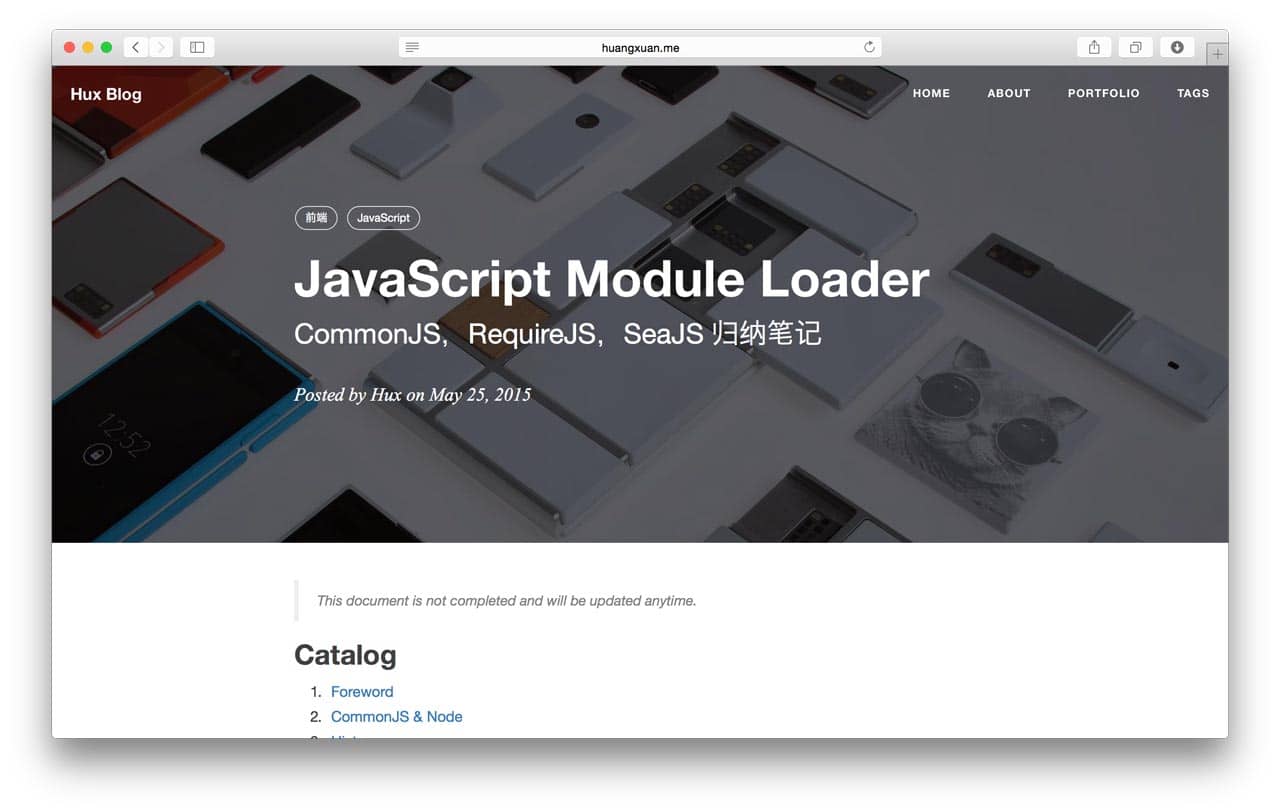#Hux Blog
- Comment and Analytics is configurable now! We also add Google Analytics support and drop tencents. Both documents is updated.
- Featured Tags is now independent of SideBar. Both documents is updated.
- New SEO Title for SEO usage which is differ from the site title
- Support PingFang (苹方), the new Chinese font presented by OS X El Capitan
- Big Improvement to the Navigation Menu (especially in Android): Dropping the old, stuttering, low-performance Bootstrap collapse.js, replaced with an own wrote, jank free navbar menu in a pretty high-performance implementation of Google Material Design.
- Brand new Keynote Layout is provided for easily posting beautiful HTML presentations you have created with this blog
- We now support a clean and gorgeous SideBar for displaying more info
- Friends is also added as a common feature of blog help you do SEO
- Full-feature Tag support
- Mobile first user experience optimization
- Typographic optimization for Chinese Fonts
- Network optimizaition for China, dropping Google webfont, using local CDN
- Using Github Flavored Markdown
- Using Baidu, Tencent/QQ analytics (TODO: support GA)
- Using DuoShuo as the Disqus-like third party discussion system
- Feel free to fork. I'll Appreciate it if you keep the Author & Github link footer
- Give it a Star if you like, fork or just clone to use ;)
- If any problem or requirement, just open an issue here and I will help you.
- 如果有需要,我可以更新一篇中文文档 ;)
- Get Started
- Components
- Comment & Analysis
- Advanced
If you have jekyll installed, simply run jekyll serve in Command Line
and preview the themes in your browser. You can use jekyll serve --watch to watch for changes in the source files as well.
You can easily get started by modifying _config.yml:
# Site settings
title: Hux Blog # title of your website
SEOTitle: Hux Blog # check out docs for more detail
description: "Cool Blog" # ...
# SNS settings
github_username: huxpro # modify this account to yours
weibo_username: huxpro # the footer woule be auto-updated.
# Build settings
# paginate: 10 # nums of posts in one page
There are more options you can check out in the Jekyll - Official Site, or you can directly dive into code to find more.
Feel free to checkout Markdown files in the _posts/, you will quickly realized how to post your articles with magical markdown plus this nice theme.
The front-matter of a post looks like that:
---
layout: post
title: "Hello 2015"
subtitle: "Hello World, Hello Blog"
date: 2015-01-29 12:00:00
author: "Hux"
header-img: "img/post-bg-2015.jpg"
tags:
- Life
---
Seeing more information may be necessary for you to display, from V1.1, a clean, gorgeous SideBar is added for you, which provide more area for displaying possible modules. You can enable (it is default enable) this feature by simply config:
# Sidebar settings
sidebar: true
sidebar-about-description: "your description here"
sidebar-avatar: /img/avatar-hux.jpg # use absolute URL.
We default support Featured Tags, Mini About Me and Friends these three modules and you can add your own. The sidebar is naturally responsive and would be push to bottom in a small screen size (<= 992px, according to Bootstarp Grid System)
More details of these three separate modules are talking below.
Mini-About-Me module display all your SNS buttons also your avatar and the description if you set sidebar-avatar and sidebar-about-description which is very useful and common for a sidebar so it is default with your sidebar.
It is really nice-looking and well-designed. It would be hidden in a small screen seeing the sidebar would be push to bottom and there is already a footer including SNS feature which is similar.
Considering the Featured-Tags feature in Medium is pretty cool, so I add it in my blog theme also.
This module is independent of sidebar from V1.4, so it can definitely live without enable sidebar, which would be displayed in the bottom when sidebar set to false, and it is not only displayed in home page but also every post page bottom.
# Featured Tags
featured-tags: true
featured-condition-size: 1 # A tag will be featured if the size of it is more than this condition value
The only one thing need to be paid attention to is the featured-condition-size: A tag will be featured if the size of it is more than this condition value.
Internally, a condition template {% if tag[1].size > {{site.featured-condition-size}} %} is used to do the filter.
Friends is a very common feature of a blog seeing the SEO, so I add it in V1.1 release to help that.
Friends can also live without enable sidebar, also be displayed in the bottom when sidebar unable, and be displayed in every post page bottom.
You can just add your friends information in _config.yml with a familiar JSON syntax and everything is done, very easy:
# Friends
friends: [
{
title: "Foo Blog",
href: "http://foo.github.io/"
},
{
title: "Bar Blog",
href: "http://bar.github.io"
}
]
There is a increasing tendency to use Open Web technology to create keynotes, presentations, like Reveal.js, Impress.js, Slides, Prezi etc. I consider a modern blog should have abilities to post these HTML based presentation easily also abilities to play it directly.
Under the hood, a iframe is used to include webpage from outer source, so the only things left is to give a url in the front-matter:
---
layout: keynote
iframe: "http://huangxuan.me/js-module-7day/"
---
The iframe will be automatically resized to adapt different form factors also the device orientation. A padding is left to imply user that there has more content below, also to ensure that there is a area for user to scroll down in mobile device seeing most of the keynote framework prevent the browser default scroll behavior.
This theme is using DuoShuo as the Disqus-like third party discussion system seeing the network issue, if you wanna switch to Disqus and feel difficult to do that, please let me know and I will support it officially.
First, you need to sign up and get your own duoshuo account. Repeat, DO NOT use mine! (maybe I will clean it up someday!)
It is deathly simple to sign up and you will get the full power of duoshuo management system. Please give it a try!
Second, from V1.5, you can easily complete your comment configuration by just adding your duoshuo short name (the second-level domain of your duoshuo account which is unique) into _config.yml:
duoshuo_username: huxblog # write down your own
To the old version user, it's better that you pull the new version, otherwise you have to replace code in post.html, keynote.html and about.html
Furthermore, if you only wanna use comment without sharing, you can set duoshuo_share: false.
Disabling the whole thing is also easy, and just comment out the code.
From V1.5, we support Google Analytics and Baidu Tongji officially with a deathly simple config:
# Baidu Analytics
ba_track_id: 4cc1f2d8f3067386cc5cdb626a202900
# Google Analytics
ga_track_id: 'UA-49627206-1' # Format: UA-xxxxxx-xx
ga_domain: huangxuan.me
Just checkout the code offered by Google/Baidu, and copy paste here, all the rest is already done for you.
If you wanna do more customization and change code yourself, a Grunt environment is also included. (Thanks to Clean Blog.)
There are a number of tasks it performs like minification of the JavaScript, compiling of the LESS files, adding banners to keep the Apache 2.0 license intact, and watching for changes. Run the grunt default task by entering grunt into your command line which will build the files. You can use grunt watch if you are working on the JavaScript or the LESS.
Try to understand code in _include/ and _layouts/, then you can modify Jekyll Liquid template directly to do more creative customization.
Change header images of any pages or any posts is pretty easy as mentioned above. But, thanks to issue #6 (in Chinese) asked, how to make it looks great?
Well...it is actually a design issue, not a coding stuff. It is better that you have basic design knowledge, but not is ok, let me told you how to make it well-designed:
Seeing the title text above image is white, the image should be dark to emphasize the contract. so we can easily add a black overlay with fews of opacity, which is depends on the brightness of the original images you used. you can process it in Photoshop, Sketch etc.
In technical views, it can be done with CSS. However, the opacity of the black overlay is really hard to assigned, every image has different brightness so the degree it should be adjusted is different so it is impossible to hard code it.
Before V1.4, site setting title is not only used for displayed in Home Page and Navbar, but also used to generate the <title> in HTML.
It's possible that you want the two things different. For me, my site-title is “Hux Blog” but I want the title shows in search engine is “黄玄的博客 | Hux Blog” which is multi-language.
So, the SEO Title is introduced to solve this problem, you can set SEOTitle different from title, and it would be only used to generate HTML <title> and setting DuoShuo Sharing.
This theme is forked from IronSummitMedia/startbootstrap-clean-blog-jekyll
Thanks Jekyll and Github Pages!



